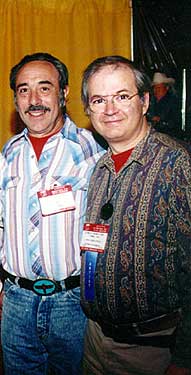Me and guns
As long as I can remember, I have had an interest in firearms. My parents had no love for them at all, but supported me in my interest.
My interest was smoldering as I played "cowboys and Indians" and I looked for the best, most realistic cap-pistol. I wish my mother had saved my Tom Mix revolver--it would be worth lots now! My interest took flame, at age 10, when I went to a summer camp and found the riflery program. Over the next four years I worked each summer on shooting and got as far as the NRA Sharpshooter first bar (Junior division) when my interest got diverted into playing guitar. Intending to return to the camp as a Counselor in Training for riflery, I instead came back as a Counselor in Training in folk music.
Stoeger's Gun shop |
But my interest in firearms continued. My dad would take me every weekend
to Agramonte's Gun Shop in downtown Yonkers, New York where he would leave
me while he went shopping, and I got to handle a lot of rifles of which
I had only seen pictures. This was back when the rifles were out, unlocked,
in racks. I can still remember the original Winchester 1866 with its brass
receiver glowing in the rack.
Any time we went into New York City, he would take me to the Stoeger's
Gun shop showroom on 5th avenue, just across from the New York Public
Library.
On my 12th birthday I saved my money and my father bought me a Hopkins and Allen single shot .22 rolling block that I had been eyeing. On my 13th birthday, my parents bought me a Marlin 39A Lever action .22, and I did a lot of shooting with it during the times I was at summer camp.
By the time I was 18, a number of guns passed through my hands from sources I can't even remember-- A 10 ga. Belgian shotgun, a Mossberg bolt-action .22, and two Arisaka rifles that an uncle brought back from W.W.II. Thankfully, arms laws were loose in those days, and it was common for youngsters to own long-arms and trade them with like minded friends-- a far cry from the inner-city and its violence we witness today around the world.
Lou Gillotti and me in 1984 at Scotty's Steel Guitar Convention in St. Louis |
In 1959 I was playing banjo with a band in Connecticut when someone introduced me to Lou Gillotti, the fiddle player in another band. Lou not only played fiddle, but loved pistol shooting. I had never fired a pistol-- I was living in New York and laws governing pistol possession there were very strict. I would drive to his farm every other weekend and we would shoot at tin cans with a variety of guns from .22's to .44 specials. I remember the first time with the .44. We set up a 5 gallon oil can at about 100 yards, and shot at it while sitting and resting our two-hand-hold on our knees. The sun was behind us and we could see the glare of the bullet heading downrange. "Bang". . . . . . . "clunk."
In 1965 I took an industrial design job in New Jersey. The first thing I did, being free of New York, was to buy a pistol-- a K-22 Smith and Wesson. Within two years I found a beautiful K-38 with an 8 3/8" barrel and bought that.
The next few years I shot on occasion with friends, but found other things to occupy my time. In 1970 I moved to Philadelphia to accept a teaching position at the University of the Arts and there met some musicians who were deeply involved in shooting and collecting. I had joined the National Rifle Association in 1968, becoming a life member in 1977.
I was fascinated with Winchesters-- specifically those that were designed by John Browning. As a teacher of industrial design, I found that Browning's work epitomized the creative process in mechanical linkages. A friend's father had worked at Winchester when he was a young man, and had met John Browning on several occasions. It was a treat to hear of his recollections. Before people were so wary of guns, I used to bring my collection to school to discuss the Winchesters as "mechanisms" and as works of three-dimensional and ergonomic design.

